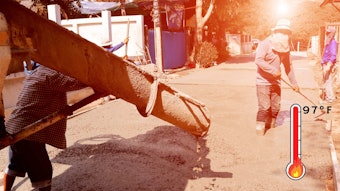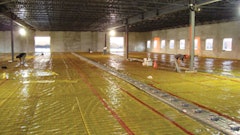
The California Department of Transportation (Caltrans) is one of the largest state departments of transportation in the nation, managing more than 50,000 miles of California’s highways, or about double the entire circumference of Earth. That’s a lot of roads for which engineers are responsible.
Caltrans takes the development of its engineers very seriously through a rigorous training program. Engineers are expected to successfully complete the Bridge Design Academy, which has been offered since the 1960s when Caltrans was known as the Department of Public Works, Division of Highways.
Caltrans’s engineering training went through several iterations throughout the years, and with the advent of the COVID-19 pandemic in 2020, another format change became necessary. Like almost all in-person events, the academy’s seven-week course became virtual. Now as we move forward, Caltrans is offering its courses in the classroom once again and has turned to Precast/Prestressed Concrete Institute (PCI) eLearning courses.
Excellent Learning Materials
Caltrans requires its engineers to complete 10 courses in its academy. All are based on Precast/Prestressed Concrete Institute (PCI) publications and the American Association of State Highway and Transportation Officials (AASHTO) Load and Resistance Factor Design (LRFD) Specification. All courses are available at the PCI eLearning Center. There are a variety of topics in the 28 free transportation-related modules for precast, prestressed concrete bridge solutions.
“These courses, some of which were sponsored by the U.S. Department of Transportation (DOT) and balloted by PCI, were selected because they offer excellent learning materials related to bridge design,” said Razia da Cruz Ferreira, a transportation engineer at Caltrans.
Started in the 1960s, the Caltrans Bridge Design Academy takes seven weeks to complete and covers bridge design, project delivery, and project engineering topics such as load rating, maintenance design, environmental engineering, planning, accelerated bridge construction, quality, and risk management.
“Workforce development is a major concern for many state highway agencies,” said William Nickas, PCI’s managing director, transportation systems. “It’s nice to see state highway official taking note of the workforce development resources available in the PCI eLearning Center and sending their staff to complete these courses. I expect PCI will see an increase in the number of participants using this free professional development hours (PDH) learning management system.”
 Adobe Stock Images | By Lev
Adobe Stock Images | By Lev
According to the Federal Highway Administration, California is one of eight states with more than 30% of its state roads classified as poor. The state has the second-highest number of bridges in the nation.
“As a former student myself, I can also say that the Bridge Design Academy was the best investment of my engineering career,” says da Cruz Ferreira. “The hands-on training, I received and the network I formed set me up for a successful career and I am very grateful to have had that opportunity.”
In addition to its close relationship with Caltrans, PCI has been an important player in precast concrete bridge construction for many years. PCI has been a member of the National Concrete Bridge Council (NCBC), a council of allied industry organizations dedicated to quality concrete bridge construction in the U.S., since it formed 25 years ago. Its goals include promoting quality in concrete bridge construction and preservation, and gathering and disseminating information on the design, construction, and condition of concrete bridges.
Precast Concrete’s High-Performance
Ultra-High-Performance Concrete (UHPC) has the potential to be a game-changer and replace conventional concrete in many large-scale transportation and building applications. UHPC has the ability to be cost-competitive on a first-cost basis while being far more valuable than conventional concrete on a life-cycle basis. By taking advantage of the key properties of UHPC, bridge members will use materials more efficiently while also being able to span farther, improving space utilization and enhancing the safety of people and vehicles. Lower consumption of construction materials will benefit the environment because of its potential to reduce carbon dioxide emissions.
UHPC differentiates itself from conventional concrete in many ways: its high-compressive strength, its high pre- and post-cracking tensile strength, and its enhanced durability due to high density and discontinuous pore structure.
PCI has been a longtime supporter of the American Association of State Highway and Transportation Officials (AASHTO). AASHTO is working on design and specification guidance for UHPC bridge structures. An update on this initiative is expected in late 2023.
To learn more about UHPC, download for free “Guidelines for the Use of Ultra-High-Performance Concrete (UHPC) in Precast and Prestressed Concrete.”
Precast Concrete Construction & the Environment
PCI’s first released guidance on precast concrete and sustainability in 2010 focused on best practices for sustainable building design and construction. More than a decade later, the transportation market is adhering to its importance. The Federal Highway Administration has developed ratings systems for the transportation industry. Also, like the buildings construction industry, material procurement regulations are affecting the transportation industry. PCI supports all such efforts.
Similarly, PCI and its members stay abreast of various code changes, such as those agenda items that were developed at the 2022 Annual Meeting of the American Association of State Highway and Transportation Officials (AASHTO) Committee on Bridges and Structures in June. These agenda items include Lightweight Concrete Clarifications, Concrete Anchors, Minimum Bar Bend Diameter, Reinforcing Bar Anchorage, Tensile Force in Concrete for Determining Tensile Stress Limit, and Use of 0.7-inch-Diameter Strands in Precast Pretensioned Girders. These issues are intended to improve the structural design and construction of precast concrete bridges by simplifying the design process, reducing ambiguity in design provisions, and establishing consistency.
About the author
Tom Bagsarian is the editorial content manager for the Precast/Prestressed Concrete Institute.

























